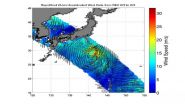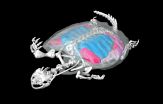(Press-News.org) BOSTON (November 7, 2014) -- Researchers at Dana-Farber/Boston Children's Cancer and Blood Disorders Center have found a way to defeat one of the most tantalizing yet elusive target proteins in cancer cells - employing a strategy that turns the protein's own molecular machinations against it.
In a study published online by the journal Cell, the scientists used a specially crafted compound to disrupt the protein's ability to rev up its own production and that of other proteins involved in tumor cell growth. The result, in laboratory samples of neuroblastoma cancer cells and in mice with an aggressive form of neuroblastoma, was death of the cancer cells and retreat of the animals' tumors, with little or no harm to normal cells. Neuroblastoma is a pediatric cancer that begins in embryonic nerve cells and generally occurs in infants and young children.
The study focused on a cell protein called MYCN, one of a family of proteins that are notorious not only for stimulating the growth and proliferation of cancer cells, but also for their ability to evade targeted drug therapies. Like other members of the MYC family, MYCN has proved very difficult for targeted agents to reach and latch onto, making it, for all intents and purposes, "undruggable." Researchers are hopeful that the approach they used in this study of neuroblastoma may prove effective against some of the many other cancers also characterized by a surplus of MYC-family proteins in tumor cells.
MYCN and its kin are "transcription factors," proteins that bind to DNA and influence the rate at which genetic information is used by the cell - essentially serving as brightener/dimmer switches for gene activity. "Recent studies have shown that when transcription factors like MYC are mutated or overabundant, they can have a cancerous effect. They cause a global rise in gene expression, making genes throughout the cell more active," says the lead author of the new study, Edmond Chipumuro, PhD, of Dana-Farber Cancer Institute. "Because transcription factors have proven so difficult to block with targeted therapies, we wanted to see if an alternative approach that targets these defective transcriptional mechanisms would be effective."
Although very rare in children older than 10, neuroblastoma is by far the most common cancer in infants. It accounts for about 7 percent of all cancers in children, and 15 percent of all pediatric cancer deaths.
The type of neuroblastoma studied by the investigators is distinguished by a glut of MYCN protein in the tumor cells. Such "MYCN-amplified" disease accounts for about 50 percent of all cases of aggressive neuroblastoma.
One of the genes that becomes hyperactive through this process is MYCN itself - producing a self-perpetuating loop in which surplus MYCN spurs the production of more MYCN, which results in an even greater surplus and more cancerous growth.
Transcription factors like MYCN work by summoning certain "co-factor" proteins to attach themselves to specific sections of DNA. The co-factors work like miniature pep squads, spurring nearby genes into activity. When MYCN is amplified, as in many cancer cells, it performs its work indiscriminately: Too many gene-activating proteins congregate at many long stretches of DNA. These stretches are known as "super-enhancers" because they turbocharge the activity of neighboring genes.
One of the many proteins used in the assembly of a super-enhancer is CDK7. This is the protein that researchers sought to block in the current study.
Chemical biologists led by Dana-Farber's Nathanael Gray, PhD, designed and custom-made a compound called THZ1 that forms a particularly strong bond with CDK7, rendering the protein essentially nonfunctional. When researchers treated laboratory samples of MYCN-amplified neuroblastoma cells with THZ1, the tumor cells died, but normal cells were unaffected. When they used the agent to treat mice with this type of neuroblastoma, the tumors shrank markedly, with no negative side effects for the animals.
"Because normal cells don't acquire super-enhancers on these master regulators, the agent had a profound impact on neuroblastoma tissue but not on normal tissue," says the study's senior author, Rani George, MD, PhD, of Dana-Farber/Boston Children's. "We've shown that it is possible to stifle MYCN itself as well as the effects of MYCN amplification."
Work is now underway to develop THZ1 into a drug that can be tested in human patients.
INFORMATION:
The co-authors of the study are Eugenio Marco, PhD, Camilla Christensen, PhD, Tinghu Zhang, PhD, Clark Hatheway, Bandana Sharma, PhD, Caleb Yeung, Abigail Altabef, Kwok-Kin Wong, MD, PhD, Guo-Cheng Yuan, PhD, and Nathanael Gray, PhD, of Dana-Farber; Nicholas Kwiatkowski, PhD, Brian Abraham, PhD, and Richard Young, PhD, of the Whitehead Institute for Biomedical Research at the Massachusetts Institute of Technology; and Antonio Perez-Atayde, PhD, of Boston Children's Hospital.
The study was supported by grants from the National Institutes of Health, American Cancer Society, U.S. Department of Defense, and Friends for Life Neuroblastoma Foundation.
About Dana-Farber/Boston Children's Cancer and Blood Disorders Center
Dana-Farber/Boston Children's Cancer and Blood Disorders Center - the nation's #1 pediatric cancer program, according to US News & World Report 2014-15 - brings together two internationally known research and teaching institutions that have provided comprehensive care for pediatric oncology and hematology patients since 1947. The Harvard Medical School affiliates share a clinical staff that delivers inpatient care and surgery at Boston Children's Hospital and most outpatient care at Dana-Farber Cancer Institute.
NASA's newest Earth observing mission, the International Space Station-Rapid Scatterometer, or ISS-RapidScat provided a look at the winds within post-tropical cyclone Nuri on Nov. 5 and 6 as it moved parallel to Japan. Nuri has moved across the Pacific and is expected to bring hurricane-force wind gusts to Alaska's Aleutian Islands today, Nov. 7.
"RapidScat passed over Nuri, near Japan, three times within a 24 hour period," said Doug Tyler of NASA's Jet Propulsion Laboratory, Pasadena, California. "The progression [in three images] showed Nuri's path."
RapidScat measured ...
New York - As Americans face growing health and financial burdens from preventable, non-communicable diseases such as cardiovascular disease, diabetes and certain cancers, a new study demonstrates employers have a unique opportunity to improve Americans' health. The research is led by Dr. Katherine Tryon and Dr. Derek Yach from the Vitality Institute and is published in the November issue of the Journal of Occupational and Environmental Medicine.
The study, which involved a first-of-its-kind comprehensive review of existing research into workplace health programs, notes ...
In a new study published in the scientific journal Oncotarget researchers from Uppsala University show that a therapeutic vaccine directed against tumor vessels can reduce tumor burden and suppress formation of spontaneous lung metastases in a mouse model for metastatic breast cancer.
The target molecule of the immunization strategy is the extra domain-A (ED-A) of fibronectin, a protein domain which is highly selective for the tumor vasculature in the adult.
"The vaccination approach we have employed is not prophylactic but therapeutic, meaning that immunity was induced ...
Tropical Cyclone 05B was meandering in the Bay of Bengal on Nov. 8, but forecasters expect it to move west and head toward east-central India for landfall. NASA-NOAA's Suomi NPP satellite captured a visible image of the tropical storm off India's coast.
When Suomi NPP flew over Tropical Cyclone 05B (TC05B) on Nov. 7 at 08:09 UTC (3:09 a.m. EST), the Visible Infrared Imaging Radiometer Suite or VIIRS instrument aboard captured a visible image of the storm. The VIIRS image showed a band of thunderstorms wrapping into the center from the northern quadrant, and fragmented ...
Amyotrophic lateral sclerosis (ALS) is a very severe disease that mainly affects the motor system. Recently the focus of public attention thanks to a viral campaign (remember last summer's ALS Ice Bucket Challenge?), ALS leads to progressive paralysis and ultimately death. Among the lesser known symptoms of the disease are cognitive impairments, which may even involve full-blown dementia. One of them is a selective difficulty in understanding and using verbs denoting actions, which these patients find much more challenging to process compared to nouns denoting objects. ...
This news release is available in German.
How can a sequence of dance steps best be learned? This question was the subject of a project led by researchers from Bielefeld University and the Palucca University of Dance in Dresden, who developed the study along with dancers and dance instructors. Together they researched whether dancers learn a dance sequence better by seeing or by listening, that is, if a dance instructor first demonstrates the sequence, or if he or she first gives a spoken explanation. The research article detailing the results of this study was recently ...
Through the careful study of modern and early fossil tortoise, researchers now have a better understanding of how tortoises breathe and the evolutionary processes that helped shape their unique breathing apparatus and tortoise shell. The findings published in a paper, titled: Origin of the unique ventilatory apparatus of turtles, in the scientific journal, Nature Communications, on Friday, 7 November 2014, help determine when and how the unique breathing apparatus of tortoises evolved.
Lead author Dr Tyler Lyson of Wits University's Evolutionary Studies Institute, the ...
Being shown pictures of others being loved and cared for reduces the brain's response to threat, new research from the University of Exeter has found.
The study discovered that when individuals are briefly presented pictures of others receiving emotional support and affection, the brain's threat monitor, the amygdala, subsequently does not respond to images showing threatening facial expressions or words. This occurred even if the person was not paying attention to the content of the first pictures.
Forty-two healthy individuals participated in the study, in which ...
Last year CERN announced the finding of a new elementary particle, the Higgs particle. But maybe it wasn't the Higgs particle, maybe it just looks like it. And maybe it is not alone.
Many calculations indicate that the particle discovered last year in the CERN particle accelerator was indeed the famous Higgs particle. Physicists agree that the CERN experiments did find a new particle that had never been seen before, but according to an international research team, there is no conclusive evidence that the particle was indeed the Higgs particle.
The research team has ...
This news release is available in German. Microbiologists and molecular biologists at ETH Zurich and the University of Bonn have discovered a new agent in fungi that kills bacteria. The substance, known as copsin, has the same effect as traditional antibiotics, but belongs to a different class of biochemical substances. Copsin is a protein, whereas traditional antibiotics are often non-protein organic compounds.
The researchers led by Markus Aebi, Professor of Mycology, discovered the substance in the common inky cap mushroom Coprinopsis cinerea that grows on horse ...







